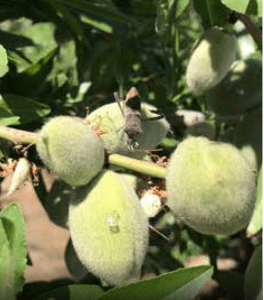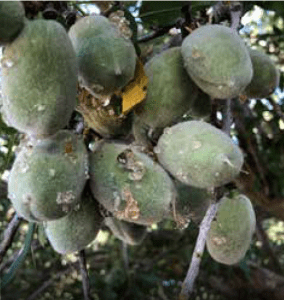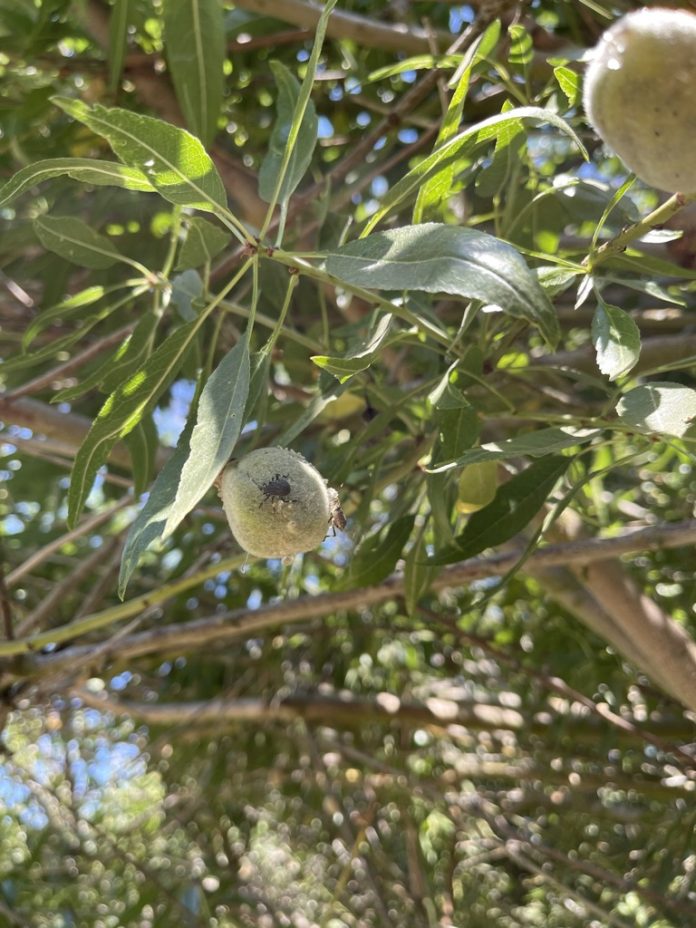Brown spot damage caused by plant bugs is on the rise, resulting in higher rejection rates and blemishes on the bottom line for growers. Since 2017, the most severe cases of brown spot accounted for nearly half of the damage experienced by some growers. In extreme instances, kernel deliveries to handlers were rendered as oil stock, where the crop was discarded, and growers were left without a return on their months-long investment.
Latest Culprit: Brown Marmorated Stink Bug
Brown spot can be caused by a variety of true bugs, such as native stink bugs, which use their needle-like mouth to probe through the hull and into the kernel. Across the industry, experts are seeing two types of bugs increasingly responsible for brown spot damage in almonds, one of which is the brown marmorated stink bug (BMSB).
“The brown marmorated stink bug is a relative newcomer,” said Jhalendra Rijal, UCCE integrated pest management advisor for Merced, Stanislaus and San Joaquin counties. “We first saw it in 2017 in only one orchard, and now we’re seeing it more frequently, and in more orchards and more counties.”
BMSBs are approximately 3/4-inch long with brown marmorated, or marbled, shading on their upper body surface. The bug feeds exclusively on the reproductive structure of plants, such as fruit, and in some cases flowers, causing significant economic damage to a variety of crops.
The first reported BMSB infestation of an almond orchard occurred near Modesto and has since spread to orchards in the northern San Joaquin Valley, where it has caused the most damage over the past six years.
“It’s established in the majority of counties along Highway 99, from Butte, even Colusa and Glenn counties, all the way down to Fresno County,” Rijal said. “The tricky thing about BMSB is that it can establish in an urban area because it feeds on ornamental trees and we may not see it in a crop at first in many cases.”
Warmer winters in California may be one possible reason for the recent geographic spread and rise of the BMSB population.
“The BMSB adults overwinter in relatively warmer places, using people’s houses or any kind of structure, such as wood or junk piles,” Rijal said. “So, when there is a mild winter, there’s less overwintering mortality, and they might come out early because of the warmer conditions.”
Due to its penchant to overwinter in undisturbed areas, the BMSB invades orchards quickly and in large populations.
“BMSB just doesn’t go to the orchard, feed and stay there,” Rijal said. “They come to the orchard, feed and then fly back.”
Within two weeks after emergence in the spring, overwintering adults will mate, with females laying a cluster of around 28 eggs on the underside of leaves. Eggs are light green when first laid, gradually becoming whiteish near and after hatching. A single female BMSB can produce more than 480 eggs in a lifetime.
On the Rise: Leaffooted Bugs
As with the brown marmorated stink bug, higher instances of brown spot caused by the leaffooted bug (LFB) have been reported in recent years. The LFB is about one inch in length, with a narrow brown body and a yellow or white zigzag line across its flattened back.
LFB has also benefited from recent mild winters, allowing a higher percentage of its adult population to survive into the spring, enabling a larger March or early April flight.
“Late in the fall, LFB moves from almond or pistachio orchards to some other hosts, like pomegranates,” Rijal said.” After they feed there, they go somewhere else. It’s not exactly clear where they overwinter, but we do see them in cypress trees and in some bulk, dense trees where they can hide.”
Following their overwintering period, LFB moves into orchards, with females laying strands of usually 10 to 15 eggs, often found on the sides of almond hulls. One LFB adult female can lay more than 200 eggs in the first two months of spring.

Spotting Damage in the Orchard
From March to early May, BMSB and LFB can feed on young nuts before the shell hardens, causing the embryo to abort and drop to the ground.
“We’ve gone into orchards along Interstate 5, west of Fresno, and we suddenly see a tree where all the nuts have dropped off like a shaker shook them off the tree; green,” said Patrick Romero, an almond grower and independent PCA. “These are green nuts; I mean they haven’t even started to hiss or crack. I think this is more common in dry years because the weeds dried down early and the insects need a host plant to live on.”
Growers will see the telltale sign of gummosis on the nut. LFB usually feeds on one or two spots per nut, resulting in thread-like gumming. BMSB feeding results in multiple gumming spots per nut, with glob-like gumming.
Based on field observations by PCAs, UCCE and handler field staff, certain varieties of almonds tend to be more susceptible to damage from BMSB and LFB, including Price, Fritz, Aldrich, Sonora, Monterey and Butte.
After the shell hardens, BMSB (and native stink bugs, mainly green stink bug) can still cause damage to nuts late in the growing season through July. The bug can probe through the hull and shell with its piercing-sucking, needle-like mouth, injecting a digestive enzyme upon feeding to liquify plant tissue. This leaves a brown spot on the kernel, damage nearly identical to that caused by the green stink bug.
Brown spot from insect damage should not be confused for hull rot, but Romero says there’s a way to distinguish between the two.
“When the nut begins to crack, it becomes very susceptible to any humidity and the shell can start to rot in the green hull, which can stain the kernel,” Romero said. “You can tell if you take a knife and cut through that spot. If it’s a deep, recessed brown injury, then it’s an insect. If it’s just superficial, just under that brown skin of the kernel, then it’s hull rot.”

A Brown Spot on Growers’ Bottom Line
Mel Machado, vice president of member relations at Blue Diamond Growers, has closely monitored the uptick of brown spot damage caused by insects.
“We’re seeing up to 30% of the total rejects caused due to brown spot. So, if you have 1% to 2% overall rejects, then about a third could be caused by leaffooted bugs or stink bugs and the brown spot they leave. There’s been cases where if a grower didn’t have brown spot, they wouldn’t have had a reject problem. I have been watching this trend grow and it scares me.”
Machado says he has seen some growers lose their entire load due to brown spot, a huge economic loss.
“There were guys that had 15% to 20% total rejects and it was all brown spot,” Machado said. “My goal is to have growers at 2% or less on reject damage because that’s where the premiums really kick in. If you’re at 15% to 25% damage, that’s a couple thousand dollars of loss per acre.”
Romero echoes Machado’s sentiment, encouraging growers to manage for BMSB and LFB to protect their bottom line.
“If you don’t bring into the processor a clean crop, you tend to lose more money than the drop in the price. You’re going to get paid less per pound because you didn’t spend another hundred or two hundred dollars an acre trying to control an insect or a disease.”
Managing for BMSB
A close look at or removal of potential BMSB overwintering sites, such as structures and woodpiles near to the orchard, help to reduce the BMSB population.
“If you have early season hosts, such as trees of heaven (Ailanthus trees), near the orchard, that tree species most likely supply BMSB to the orchards,” Rijal said. “We have observed this in many orchards where tree of heaven is nearby. It is the most preferred non-crop host of BMSB.”
According to Rijal, growers can use a trap baited with a BMSB aggregation pheromone and pheromone synergist, methyl decatrienoate, to monitor adults and nymphs all season long.
“Fortunately, we have a trap for BMSB, which we don’t have for the rest of stink bugs,” Rijal said. “Several PCAs and growers are using it once they find they have damage.”
However, Rijal notes that a treatment threshold has not been developed for the pest. The recommended best management practice at this time for growers who have BMSB in traps and confirmed visual surveys is consideration of a spring application for control.
“The best insecticide to use in the early season to control BMSB is a broad-spectrum pyrethroid, but these are also the ones that can kill beneficial insects” Rijal said. “We did some trials earlier this year with some new insecticides and we’ll have more information about these later in the year.”
Research Ongoing for Improved LFB Monitoring
For LFB, best monitoring protocols are available, but often point out damage after it’s too late to act. A multiyear effort led by UC Riverside Entomology Professor Jocelyn Millar, and funded by the Almond Board of California, has worked to improve the monitoring options for the pest.
“You can take beat samples of the crop canopy to look for adults or nymphs, but we’ve never established any kind of treatment threshold for that practice,” said Houston Wilson, assistant cooperative extension specialist in the Department of Entomology at UC Riverside and collaborator on the project. “Identifying gummosis is easier because you can look for the signs of feeding, but it’s an artifact; by the time you see it, the leaffooted bug has already damaged the nuts.”
A passive sampling system for leaffooted bug, like for navel orangeworm, where a pheromone attracts the insect to a trap doesn’t exist (yet).
Over the past five years, Millar and his team have been identifying compounds that make up the leaffooted bug pheromone. Nine compounds were identified, with the last compound identified entirely new to science.
Millar noted this new compound was a relatively small part of the overall pheromone composition, but it packed the biggest punch, triggering the strongest responses from the bugs. Over the last two years, Millar’s team has been able to collect enough material to identify the compound and synthesize it.
At the same time as the pheromone work, the team at UC Riverside, and other collaborators such as Cooperative Extension Specialist Kent Daane, began looking at the best trap for the application. They tested multiple styles of traps and colors, ultimately identifying that a hanging cross-vane panel trap coated with a sticky substance, yellow or blue in color, performed the best for trapping leaffooted bug.
With a fully recreated pheromone and an effective trap, the team ran trials in commercial almond, pistachio and pomegranate orchards in the Central Valley. Based on trials, the team concluded the trap and pheromone were effective and will look to the private sector to commercialize the new monitoring system.
The Almond Board encourages growers to consult with their trusted PCA to determine monitoring and treatment protocols specific to their operations. More information about best management practices of leaffooted bug and brown marmorated stink bug is available at the UC Statewide IPM website at ipm.ucanr.edu/agriculture/almond.











